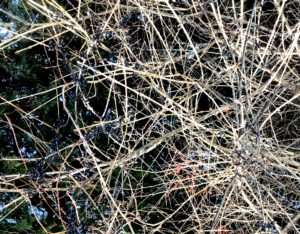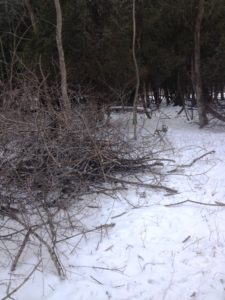Suddenly it’s winter. The luxury of a long, warm fall has finally been replaced with more seasonal conditions. The extended warmth allowed us to do more habitat work than usual- many more invasive plants were removed, and acres of land were seeded with native grasses and wildflowers in our preserves. We planted the last of about 1,500 trees and shrubs last week, a large sugar maple that will grow in memory of one of our members. We accomplished more than we planned and feel very good about the progress made.
We also worked hard to remove those Eurasian invasive plants like buckthorn, honeysuckle, and autumn olive that have been brought here as decorative plants only to damage our native ecosystems. Thousands of species of native plants, not adapted to competing with the invasives, are continually losing habitat to the foreigners. With a little help from us, they have a better chance of hanging on until they develop their own ways of coping with the competition. As nature dictates, what happens to the plants also happens to the animals.

Because our land has been invaded by harmful plants, restoration is not just a matter of happily planting and watching things grow. Restoration is often very hard work: cutting, digging, herbiciding, and piling and disposing of brush to adequately prepare the land for replanting with natives. It’s like gardening- you can’t plant vegetables in a grassy field without preparation. Restoration areas can look alarmingly disturbed with many trees and shrubs removed and piled. If you drive along Columbus Sreet and look at our preserve, you will see many brush piles of buckthorn and honeysuckle. Look closer and see the trees and shrubs that have been planted, guarded by chickenwire cages to fend off the deer. Also, you probably won’t notice the effects of the wildflower seeding that has been done for a couple of years. It looks like the forest has been torn up in places and neglected, but as you now know, this is not the case.
We’re also working with others in our community who thankfully have an interest in improving land for wildlife, including both our Cities’ park departments, the Friends of Mariners Trail, and others. In some cases there are other considerations such as preserving views of the Lake or safety issues that one tries to incorporate into the restoration plan. In public places, one frankly wants to make the area look attractive in addition to providing habitat for wildlife. This can present special challenges and takes planning but it can result in a win-win for people and wildlife.

As I write I am overlooking large brush piles of buckthorn and honeysuckle cut on my personal property. The area looks to be devastated, but my brother and I have already started planting dozens of species of native trees, shrubs, and wildflowers to take the place of what we’re removing. Right now it’s a mess, but over the winter we’ll get rid of the piles. We can’t wait to resume planting when weather permits.
So don’t despair if you see a restoration area that appears to be in a shambles. If done right, and based on science and experience, we just need to be patient and continue managing as needed. Like with so many garden projects, the best is yet to come.
photos: buckthorn brush pile at Zander park in Two Rivers and buckthorn (purple berries) and native holly (red berries) competing for space at Woodland Dunes
